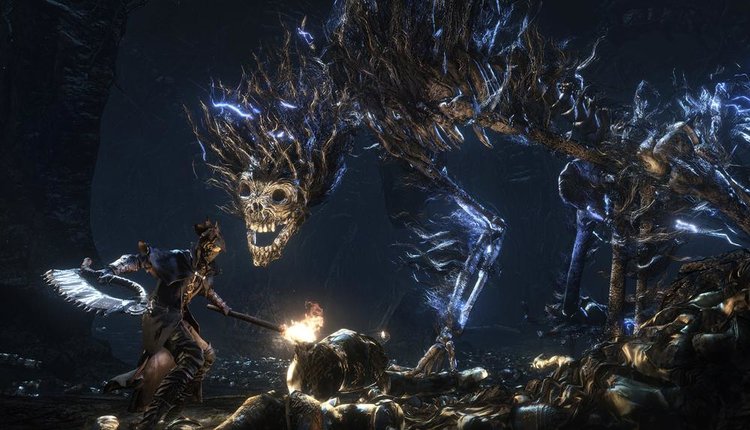Miyazaki’s New Nightmare: Lovecraftian Doom and Corrupted Faith in Bloodborne
We burn holy candles against profane darkness. We erect towering steeples on the graves of old Gods. We chant from sacred scriptures to banish unholy fears and temptations. But what if our faith itself is not enough? What if the mind-breaking horrors of what lies beyond the stars wields a power far greater and more real than that of the deities we invent to fight them? Bloodborne, Hidetaka Miyazaki’s 2015 masterpiece, asks why should the infinite, sadistic horrors of the universe care about you? It’s the player’s job, time and again, to show them why.
The City of Yharnam is cursed. After centuries of worshiping the remains of ancient, deified creatures known as Great Ones the city’s Healing Church has developed blood transfusions as a cure-all remedy. But this cure has come with a cost in the form of a lycanthropic curse. Upon their arrival in the city the player character is administered with Paleblood by an old doctor. Thus begins their journey into Yharnam’s districts as well as the nightmare realms that exist at the edges of its frayed reality. In order to end the curse that has destroyed Yharnam the Hunter must confront mind-breaking, reality-bending horrors.
Bloodborne wears its influences – from Castlevania to its sibling Dark Souls – on its sleeve but the complexity of its story and detail of its setting make it uniquely it’s own beast. Yharnam has the feel of a city newly abandoned. It’s sense of place from the rambling, leaning slums of Yharnam City proper to the high Gothic steeples of the Healing Church and from dusty, dripping Byrgenwyrth University to the hidden, twisted village of Yahar’Gul Bloodborne conjures images of Victorian London drawn straight from the mind of H. P. Lovecraft.
If the Castlevania and Dark Souls series influenced Bloodborne’s gameplay then Lovecraft’s legacy holds total sway over its setting and story. Though Yharnam and its surrounding environs are creations of Miyazaki’s own they do owe some if not all of their existence to Howard Phillips Lovecraft. The influential, and very racist, American horror writer created the Cthulu Mythos as well as a whole host of separate stories about madness inducing cosmic terror. The spelling of monstrous places and indeed the monsters within Bloodborne are drawn from Lovecraft but whereas Lovecraft only allowed the briefest of glimpses at his creations Miyazaki showed them in all their sanity shattering glory.
Certain enemies repeat themselves in Bloodborne. Sometimes bosses reappear as lower level enemies in later stages. The bosses themselves always remain unique, however. Bloodborne’s first enemy is an enormous werewolf – the likely end stage of the bestial blood curse – and it sets the tone for all future bosses. Regardless of whether they’re robe-cloaked snake-men, an enormous mushroom-headed alien, a horrifying amalgamation of the screaming dead or your own beastly brethren all of Bloodborne’s bosses share one thing in common: their bloodthirsty nature. This illuminates one of Bloodborne’s most horrifying themes.
[perfectpullquote align=”full” bordertop=”false” cite=”” link=”” color=”#70006C” class=”” size=”19"]”Bloodborne leaves you isolated and aware that you are but a step away from madness.[/[/perfectpullquote]p>
After the epitaph “Prey Slaughtered” flashes up on screen there’s a profound sense of isolation, of loneliness. In the fight against the monsters and the beasts and even undeath the Hunters are alone. They are a feeble first and last line of defense against the nightmare that threatens to flow over Yharnam’s borders and engulf the city whole. At the end of everything, even after the stars have fallen from the sky, is there anything worse than knowing that you are the only one left to face that end? Maybe it’s the fact that even after the tentacled rapture comes it’s that the white light we are promised will give way to reveal an all-consuming blackness.
Faith is or at least it was an important corner stone of Yharnam’s culture and society. No other city in a video game has as many churches except maybe Arnor Londo. The Great Ones died in eons past and Yharnam as well as the cities that came before it were built on their bones. In death the Great Ones were easily worshiped, divorced from their destructive power and madness-inducing visages they commanded Yharnam’s respect but not it’s fear. Until a new Great One was born, Mergos, and the nightmare began. All of the Healing Church’s medicine, wealth or power could not stop the corruption and eventually even their most holy orders were consumed by the darkness.

Bloodborne bosses live by one unifying rule: If they’re big hug the ass and you’ll be fine, if they’re small may God help you. Not even Hunters are immune to the blood curse or the mind-altering power of the nightmare. Few hunters are left in Yharnam and most of them such as Father Gascoigne and Eileen’s various nemeses are blood-drunk and violent. Though you may occasionally call on the help of your fellow hunters Bloodborne leaves you mostly isolated and aware that you too are but a step away from madness.
Bloodborne’s final crowning nightmare is in its repetition. From the start you’re made aware that you will die quick and often whether you’re crushed by an Ogre, poisoned by toxic mud or drained by the Blood-Starved Beast. Two of Bloodborne’s three endings have you either in control of the repeating nightmare or guiding other desperate Hunters through it. The joy of a bad dream is in knowing that it will end. If you press on in Bloodborne against the advice of your guides – the Doll and Old Hunter Gehrman – you are dooming yourself and the world to a never-ending nightmare. I can think of nothing more horrifying.

